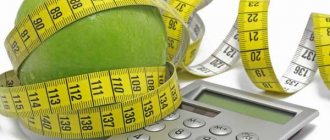Energy waste
Energy is consumed by a person continuously throughout the day, fuel for which is food. And this expense is individual for everyone. There are 2 types of energy consumption:
- Unregulated with the expenses that support our livelihoods. These figures are average for each category of the population, where men spend 1700 Kcal per day, and women 1400.
- Adjustable, related to activity during the day - the higher it is, the correspondingly greater energy consumption will be.
The energy produced from fats is 2 times less than from carbohydrates. There are established calorie expenditures based on various types of physical activity, for example, jogging consumes an average of 485 Kcal per hour, running at a pace will require the expenditure of 980 Kcal.
Calorie content is the amount of energy the body receives from food after it has been completely absorbed. To determine the energy value, food is burned in a calorimeter, and the measurement is made on the heat released into the surrounding water bath. Energy expenditure in humans is measured in the same way.
The daily requirement is based on metabolism multiplied by physical activity, which is calculated as follows - 1 Kcal per kg of weight multiplied by weight (nominal) in kg and multiplied by 24 (hours).
Calorie consumption depends not only on physical activity; age, gender, weight and individual characteristics of the body also matter.
The average protein consumption per day is from 80 to 120 g, in pregnant women it is increased - up to 150. Carbohydrates should be consumed from 400 to 600 grams. Women require less food intake compared to men.
This is interesting: TOP 10 most high-calorie foods.
Calorie consumption during sleep
All of these processes require energy, and therefore calories. This vital energy expenditure accounts for approximately 60 to 80% of the total daily calorie intake.
Moreover, the consumption of the latter is carried out continuously, even in a state of complete relaxation and rest - only, perhaps, it decreases slightly. On average, calorie consumption occurs at a rate of 1 kcal/kg/hour. Here we are talking about the value of the basal metabolism, which is 4.18 kJ.
Energy expenditure during sleep varies from 60 to 70 kcal per hour. This is quite an impressive calorie expenditure, but its implementation requires special conditions:
- firstly, the duration of sleep should be at least 8 hours per day;
- secondly, you need to sleep in a cool, pre-ventilated room;
- thirdly, it is undesirable to eat fatty and carbohydrate-containing foods immediately before bedtime;
- fourthly, you need to go to bed in a relaxed and calm state, and not in a stressful state.
Basics of rational nutrition
For normal human life, it is necessary to follow the rules of a balanced diet and regimen:
- The food should be varied, without ignoring any foods, that is, on your table there is meat, fish, cereals, bread, vegetables, fruits and herbs;
- Distribute your diet wisely, dividing your meals during the day into 3-5 meals, taking into account the rate of absorption of certain foods - meat stays in the stomach for up to 6 hours, legumes and potatoes for 4 hours, grains and bread for 2 hours;
- Set a certain regime for yourself, constantly adhering to it, allowing the correct production of gastric juice, which will contribute to good digestion;
- Be moderate in food - do not overeat, you need to get up from the table with a slight feeling of hunger;
- Chew your food slowly, without rushing;
- Try to eat in a favorable psychological and environmental environment with a beautiful table setting.
Try to follow the established diet even on holidays and weekends, without allowing yourself to relax.
After watching the video, you will learn how to count calories in foods:
How does weight loss and weight gain happen?
Weight loss and weight gain occur depending on how many calories a person needs to maintain the body’s vital functions and how many calories he actually received per day from food.
In general, losing weight and gaining weight looks like this:
- If a person needs a certain amount of calories and he consumed this amount of calories in food per day, then in this case no changes occur in the body and the person does not lose weight or gain excess weight. For example, a person needed to get 2,200 calories and he got them from food - in this case his weight will not change.
- If a person has consumed more calories in food per day than he needs, then the excess calories will be converted into subcutaneous fat, and the person will gain weight. Moreover, the greater the excess, the more fat will be deposited (however, calculating the exact amount of fat is quite difficult). For example, a person needed to get 2,200 calories, but he ate 2,500 calories - in this case, the excess food will be processed into fat, and the person will gain weight.
- If a person has consumed fewer calories per day than he needs, then subcutaneous fat will be converted into the energy the body needs, and the person will lose weight. Moreover, the greater the deficiency, the more fat will be broken down to cover the energy deficit. All diets are based on this effect - if a person eats food with a small amount of calories, then he loses weight. For example, a person needed to get 2,200 calories, but he received only 2,000 calories - in this case, the energy deficit will be covered by the breakdown of subcutaneous deficit, and the person will lose weight.
Calorie intake standards
Daily calorie intake, as mentioned above, depends on many factors, the basis of which is physical activity. Below is a table with approximate data that will help an adult navigate:
| Sedentary lifestyle (Kcal) | Moderate activity (Kcal) | Active Life (Kcal) | |
| Men | |||
| 19-30 years old | 2400 | from 2600 to 2800 | 3000 |
| 31-50 | 2200 | from 2400 to 2600 | from 2800 to 3000 |
| over 51 | 2000 | from 2200 to 2400 | from 2400 to 2800 |
| Women | |||
| 19-25 years old | 2000 | 2200 | |
| 26-50 | 1800 | 2200 | |
| over 51 | 1600 | 1800 | |
| 19-30 years old | 2400 | ||
| 31-60 | 2200 | ||
| over 61 | 2000 |
The required amount of calories entering the body also depends on your goals - whether you are struggling with excess weight or not. In the first case, the number of calories should be less than average.
A sedentary lifestyle also requires a reduced amount of them during the day.
What do we spend calories on?
A person accompanies his every action with the expenditure of energy. Another thing is that some types of activities clearly demonstrate increased energy consumption (for example, playing sports), while others are not so obvious - we don’t even think about them (physiological processes). Let's find out why the human body needs calories in order to live at its usual rhythm and feel as comfortable as possible.
Reception and processing of food entering the gastrointestinal tract. Maintaining muscle tone. Ensuring normal body temperature. Full functioning of internal organs - kidneys, heart, brain, endocrine glands, lungs (respiratory muscles). Ensuring the uninterrupted flow of metabolic reactions. Functioning of the nervous system. Dream.
Calculation methods
In the photo: products with calculated calorie content
Several methods have been invented for calculating calories per day - the Harris-Benedict, Muffin-Jeor and Ketch-McArdle formula. Let's look at each in more detail:
- To estimate basal metabolism with daily energy requirements, the popular Harris-Benedict formula is most often used. The total number shows the number of calories to consume per day if you want to maintain your current weight.
- The formula created by Muffin-Jeor is considered more accurate, but the calculation does not take into account physical activity, but only the basal metabolism.
- The Ketch-McArdle formula does not take into account weight, height and age, only weight in kg.
To obtain a more accurate method of calculating calories, it is necessary to use the basal metabolic rate (BMR), which is an indicator of the caloric intake required daily for the body to function in a calm state, without doing anything (while sleeping). One “but” - this formula is suitable for people with average body weight and it looks like this:
- Women need to add height in cm to 655, multiplied by a factor of 1.8, then add weight in kg, multiplied by 9.6 and subtract age (years) multiplied by 4.7;
- Men add height in cm multiplied by 5 to 66, then add weight in kg multiplied by 13.7 and minus age multiplied by 6.8.
Calculation of the DAC (daily calorie requirement) is carried out by multiplying the resulting BOO figure with the physical activity coefficient, of which there are several. They depend on the degree of activity and lifestyle of a person:
- In the absence of any physical activity, a coefficient of 1.2 is taken.
- Light physical labor - 1.375.
- Loads of medium and moderate activity - 1.55.
- Daily hard effort - 1.75.
- Particularly hard work - 1.9.
Knowing all these indicators, you can easily make your own calculations and stick to the resulting number of calories throughout the day.
I recommend: 10 ways to get rid of 250 calories.
Consumption table
Calorie intake is greatly influenced by a person's gender, age and lifestyle. Various nutritional organizations have calculated the optimal amount of calories so that the human body can grow and develop without problems.
The calorie consumption table depending on age, gender and lifestyle is as follows:
| Floor | Age | Sedentary eating pattern (calories) | Average activity (calories) | Active lifestyle (calories) |
| Male | 0-18 years | 1.300-2.000 | 1.800-2.400 | 2.100-2.800 |
| Male | 18-40 years old | 2.000-2.500 | 2.300-2.800 | 2.700-3.100 |
| Male | 40 or more years | 1.800-2.300 | 2.200-2.600 | 2.500-3.000 |
| Female | 0-18 years | 1.300-1.800 | 1.600-2.100 | 2.100-2.500 |
| Female | 18-40 years old | 1.700-2.200 | 2.100-2.600 | 2.600-2.900 |
| Female | 40 or more years | 1.600-2.100 | 2.000-2.400 | 2.200-2.700 |
The table is deciphered as follows:
- Inactive lifestyle. This category includes people who eat to maintain homeostasis (the body’s ability to perform its basic functions) and all physical activities that are necessary only to maintain normal functioning (walking, climbing stairs, moving arms, and so on). A person is engaged in study or light office work (writing reports, working with a computer, and so on). There are no sports activities. If a person is involved in any sports or physical labor, then in this case it is necessary to apply the norms of the “Average activity” or “Active lifestyle” group.
- Average activity. This category includes people who do not too hard work and light sports, as well as people who walk a distance of 2 to 4 km every day. This group includes traffic police officers, ambulance doctors, postmen, and so on. The total duration of sports activities is no more than 10 hours per week; sports - amateur football, slow running at a distance of up to 2 km, volleyball, tennis and so on. If a person is engaged in more difficult physical labor or plays sports more than 10 hours a week, then in this case the norms of the “Active lifestyle” group must be applied.
- Active lifestyle. This category includes people who do a lot of hard physical labor or sports. This group includes factory workers, miners, loaders, and so on. The total duration of sports activities is more than 10 hours per week. Strength sports fall into this category - weightlifting, professional team sports (football, basketball, etc.), long-distance running, and so on.
Be sure to read: Proper nutrition menu with recipes for a week for weight loss
What happens to the body when there is a lack of energy
In this publication, we calculate how many calories are spent in a state of calm per day. Now let's take a closer look at the processes that occur in the body when it does not receive the amount of necessary energy. When creating the human body, nature incorporated a unique function of self-preservation, which was successfully used. It is no secret that our ancestors could spend a long time in search of food, but successfully survived. The principle of operation of the protective mechanism remains the same to this day.
When the amount of energy consumed is reduced, the body regards the deliberate refusal of nutrition as critical conditions and goes into an economical mode of existence. First of all, metabolic processes will slow down, and this will stop fat burning. Metabolism slowed down artificially, in turn, will affect a person’s well-being, lead to loss of strength, cause headaches, and in some cases even depression. This is why you need to know how many calories you burn at rest. The calculation using the formula provided by us is not at all difficult.
If you want to lose weight
Now let's look at a situation where you need to lose extra pounds. If you have a lot of excess weight (more than 10 kilograms), you should not force things and sharply reduce the amount of food consumed. This is dangerous to health, and with long-term strict diets, the body, which does not receive sufficient energy for its vital functions, becomes depleted. In order to avoid tragedy, we need to know how many calories are burned in a state of calm. It is strictly not recommended to reduce basic energy costs even by half. A real disaster for a young body would be to consume 500 calories. The only exception may be a fasting day. Therefore, reduce the amount of calories you consume slightly and rely on healthy organic foods. In this case, you can always get rid of extra pounds with the help of additional physical activity.
Morning
Where does the morning begin, with coffee and a croissant or with water porridge and a vegetable smoothie? No, from making the bed (35 kcal), showering (10 minutes - 40 kcal), preparing breakfast (75 kcal), then washing the dishes (50 kcal), putting on makeup (60 kcal), styling (141 kcal) and, of course, choosing and trying on clothes (93 kcal). If you have a dog, then a walk with it will cost you 200 kcal for 40 minutes.
The commute to work will also not go unaccounted for. There are, however, many different options here, so choose the one that is closest to you. So, driving a car will cost you 90 kcal per hour, walking – 270 kcal, but traveling by public transport is 70 kcal if sitting, and 120 kcal if standing.
Depending on gender and body weight
An important factor in calculating calorie consumption is considered to be Since men are mostly taller and larger than the fair half of humanity, therefore, their body expends more energy. It's no surprise that the average man eats more food at one meal. So, we asked ourselves to find out how many calories are burned in a state of calm. An approximate calculation of indicators will be presented right now. We already know that the higher a person’s height, the more calories are consumed to participate in the body’s metabolic processes.











